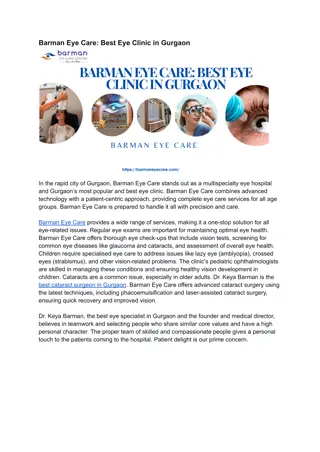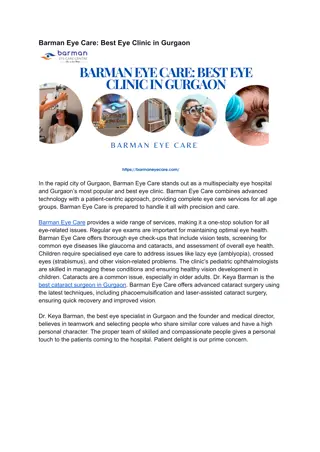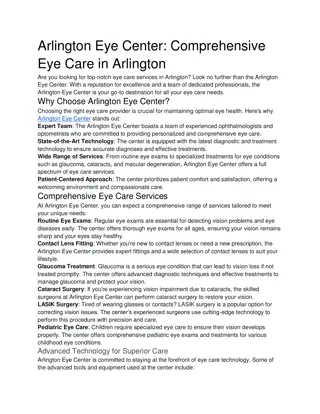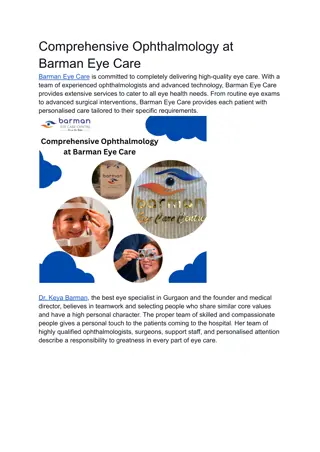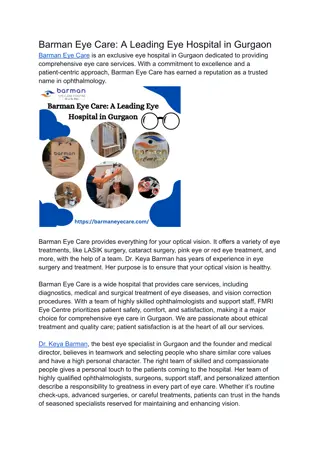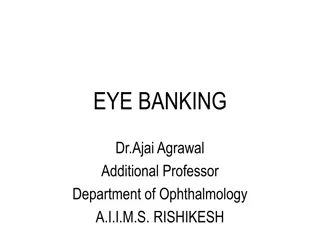
Understanding the Importance of Eye Banking and Corneal Transplantation
Explore the functions of an eye bank, from donor tissue evaluation to corneal transplantation procedures. Learn how the eye banking system works and the role it plays in preserving vision through corneal grafting. Discover the impact of public awareness programs, medical standards, and networking initiatives in advancing eye health and donation practices.
Download Presentation

Please find below an Image/Link to download the presentation.
The content on the website is provided AS IS for your information and personal use only. It may not be sold, licensed, or shared on other websites without obtaining consent from the author. If you encounter any issues during the download, it is possible that the publisher has removed the file from their server.
You are allowed to download the files provided on this website for personal or commercial use, subject to the condition that they are used lawfully. All files are the property of their respective owners.
The content on the website is provided AS IS for your information and personal use only. It may not be sold, licensed, or shared on other websites without obtaining consent from the author.
E N D
Presentation Transcript
StudyMafia.Org Eye Banking Submitted To: Studymafia.org Studymafia.org Submitted By:
Definition Definition Functions of the EyeBanking EyeBanking System How It Works ? Evaluation of donor tissue Preservation of cornea Corneal Transplantation Conclusion
Definition Eye Bank is a non profit organization which deals with the collection, storage and distribution of the donor cornea for the purpose of corneal grafting, research and supply of eye tissues to other eye banks for ophthalmic purposes.
Functions of the EyeBanking The administrative section is responsible for - Public awareness programmes - Liaison with government, local voluntary and other health care agencies - Fund raising
Functions of the EyeBanking Medical section deals with the entire technical operation of the eye bank: -Tissue harvesting, evaluation, preservation and distribution (maintaining medical quality of highest standard).
Functions of the Eye Bank Networking of eye banks under the umbrella of a national organisation ( e.g. Eye Bank Association of India) allows -Public education programmes - Institution of newer eye banking procedures - Training programmes and development of uniform medical standards
Eye Banking System Eye Donation Center (EDC) affiliated to a registered eye bank (1) public and professional awareness about eye donation (2) co-ordinate with donor families and hospitals to motivate eye donation (3) to harvest corneal tissue and collect blood for serology (4) to ensure safe transportation of tissue to the parent eye bank.
Eye Banking System Eye Bank (EB) Provide a round-the-clock public response system over the telephone and conduct public awareness programs on eye donation. Co-ordinate with donor families and hospitals to motivate eye donation/Hospital Cornea Retrieval Programs (HCRP) To harvest corneal tissue To process, preserve and evaluate the collected tissue To distribute tissue in an equitable manner for Keratoplasty To ensure safe transportation of tissue Eye Bank Training Centre (EBTC) All of the eye bank functions plus training for all levels of personnel in eye banking and research.
Eye Banking System EQUIPMENTS Slit lamp EBTC Required EB EDC Required Not required Refrigerators Required Required Preferable Serology Required Required Not required Specular microscope Required Required if collection is 200/yr Required Not required Instruments for corneal excision Required Required Autoclave Required Required Should have access Required Laminar flow hood Required Required
How It Works ? Recovery or retrieval Cornea Processing Distribution
Deceased family calls Eye Bank Grief counselor motivates and obtains consent Retrieval/ Recovery of tissue
Evaluation of donor tissue Gross examination Whole globe: eyes with excessive stromal hydration should be discarded unless specular microscopy can be done for endothelial cell count. Corneoscleral button: Colour of the tissue storage media is to be noted to rule out contamination.
Evaluation of donor tissue Slit Lamp Biomicroscopic examination
Preservation of cornea Moist chamber storage Storage of whole globe 4 C 24 hours Advantage: Simple Disadvantage: Corneal stromal edema.
Preservation of cornea Tissue Media o Dextran o Chondroitin sulphate o Electrolytes o pH buffer system o Antibiotics o Essential amino acids o Antioxidants,ATP precursors o Insulin o Epidermal growth factor o Antiprotease,anticoagulants Cornea storage Media Storage time (days) MK 4 K-SOL 7 CSM 7 DEXSOL 10 OPTISOL 14 PROCELL 14
Preservation of cornea M-K medium: Described by Mc-Carey & Kauffman. Mixture of tissue culture medium (TC-199) and Dextran (5%,40,000 MW) Buffer: HEPES (N hydroxyethyl- piperazine-N-ethane Sulphonic acid) Antibiotics:Penicillin,Gentamicin,Polymyxin Storage period- 96hrs. K-Sol: Purified chondroitin sulphate in tissue culture medium (TC 199). Storage:7-10days in 40 C.
Preservation of cornea Long term Organ Culture storage system MEM media(minimum essential media) Developed by Harry Eagle. 34 degree C Incubated at room temperature in nutrient medium Storage period : 30 days Advantage: Enables HLA matching Very long time preservation: Cryopreservation 1year
Corneal Transplantation Immune privilege of cornea Absence of blood and lymphatic channel in the graft and its bed Absence of MHC class II APCs in the graft Reduced expression of MHC coded alloantigen on graft cells Immunosupressive microenvironment of aqueous humor. Anterior chamber associated immune deviation.
Corneal Transplantation Corneal transplantation refers to surgical replacement of a full-thickness or lamellar portion of the host cornea with that of a donor eye. Allograft/autograft Full-thickness( Penetrating)/ Partial thickness ( lamellar)
Corneal Transplantation :Schematic
Conclusion Eye banks are the institutions responsible for collecting (harvesting) and processing donor corneas, and for distributing them to trained corneal graft surgeons. Eye banks are regulated and part of the local health system; they may be attached to a hospital or housed in a separate building.
References Google.com Wikipedia.org Studymafia.org Slidespanda.com
Thanks To StudyMafia.org






